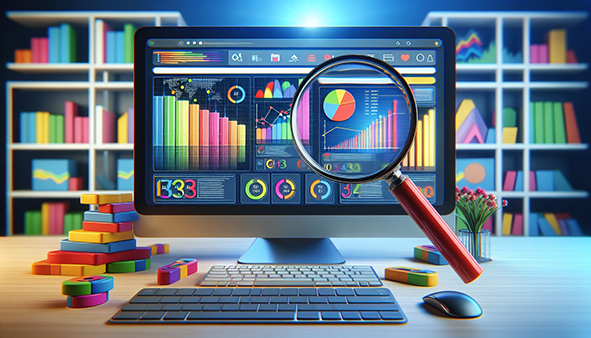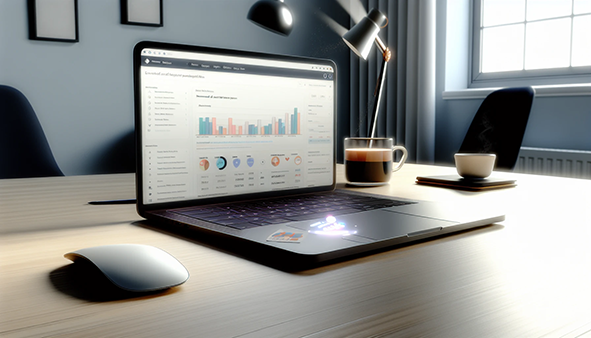Mastering Analytics for Shopify: A Comprehensive Exploration for Better Business Decisions
Using data to optimize your Shopify store and make informed decisions is easy with Analytics for Shopify. In this post, we’ll take a look at how to leverage analytics effectively by customizing reports, automating report generation, analyzing marketing performance metrics and monitoring inventory & sales in order to get the most out of your business. So start using powerful insights from raw data today!
Shopify Analytics is a powerful tool providing reports and data to monitor store performance, visitor behavior, sales, customer activity and more.
Shopify analytics enables users to customize reports for their business’ needs as well as filter & edit them for better decision making.
Integrating third party tools with Shopify can provide extended functionality & insights into store performance in order to optimize strategies & maximize returns.

With Shopify analytics, retail sales can be monitored and tracked easily with a range of reports. It provides powerful insights into the functioning of stores as well as visitor behavior including online store searches for superior decision-making capabilities. Comprehensive data extraction and export tools are also available so users benefit from greater accuracy when managing their accounts or tracking product sales levels.
The suite offers an excellent opportunity to keep up with ecommerce since it is possible to monitor customer activity while taking advantage of useful features related to maintaining an online store.
Navigating the Analytics Dashboard
When you log into your Shopify store, the reports in the left-hand menu will take you straight to its analytics dashboard. This all encompassing report gives you instant access to data that relates to customer behaviour and shop performance, it offers key figures as both numerical readings and graphical illustrations. You can also keep track of current customers through Live View (on Basic Shopify plans or above). From this analytic overview, users are able to evaluate their landing page traffic for marketing efforts more effectively plus gain an advantage over competitors with accurate insights from reporting tools like first page analysis. TheShopify Analytics Dashboard provides information which is invaluable when planning business strategies while striving for success within any online store environment!
Understanding Key Metrics
Analyzing the key metrics available in Shopify Analytics is essential to improving decision-making and optimizing store performance. Through different reports, it provides insights into orders placed, shipped, delivered or returned, customer purchases based on product type or sales channel, as well as primary data such as visits, visitors and cookies for better understanding of your business growth potential.
It’s important to monitor retail sales figures along with customers’ behavior patterns online alongside site speed which helps gauge how successful a store may be when it comes to conversions & revenue while also getting an idea about what products they are actually interested in by paying attention to top searches made from your shop. This allows you to make necessary adjustments that could lead to greater efficiency within your operations overall.
Shopify Analytics offers a variety of advanced reports that provide deeper insights into different aspects of your business. These include retail sales reports, acquisition reports, and reports on average inventory sold.
Retail Sales Reports
Retail sales reports in Shopify Analytics provide a comprehensive overview of your store's sales performance. They offer detailed insights into the number of orders, gross sales, returns, net sales, discounts, taxes, and total sales. This data helps you understand which products are selling well and which ones aren't, allowing you to make informed decisions about product stocking and marketing strategies.
Acquisition Reports
Acquisition reports in Shopify Analytics help you understand where your customers are coming from. They provide insights into the various channels that are driving traffic to your store, including organic search, paid search, social media, email, and referrals. By analyzing this data, you can identify which marketing efforts are most effective and adjust your strategies accordingly.
Average Inventory Sold Reports
Reports on average inventory sold give you a snapshot of how your inventory is moving. This includes data on the average number of units sold per order, the average selling price, and the average time it takes to sell an item. These insights can help you manage your inventory more effectively, ensuring you have enough stock to meet demand and avoid overstocking or understocking issues.
Top Online Store Searches Reports
Shopify Analytics also provides reports on top online store searches. These reports are valuable tools that can help you understand what your customers are looking for when they visit your online store. They show you the most searched terms in your store, which can give you insights into popular products or categories, potential gaps in your inventory, or even common customer questions or concerns.
By analyzing these search terms, you can tailor your product offerings, improve your site navigation, and optimize your SEO strategy to match your customers' needs and preferences. This can lead to improved customer satisfaction, increased sales, and a better overall shopping experience for your customers.

Shopify analytics offers custom reports so you can access data that is tailored to your business needs. You can create custom reports where sales are attributed to particular marketing channels and analyze the shopping cart for online store insights.
The custom reports abilities of Shopify enable businesses to look more deeply into their figures in order gain knowledge which they use to optimize their stores’ performance.
Using Filters and Editing Features
Gaining insight into your business using Shopify custom reports is easy, even for those new to the platform. To customize a report and utilize data more effectively, just follow these steps:
Load up any given report
Click on the filter icon in order to open Manage Filters 3. Hit Add Filter 4. Pick an option from the available drop-down menu 5 Edit it as desired 6 Apply filters upon finishing customization process.
The ability to tailor existing reports by manipulating their contents. Which can include filtering information, rearranging columns or changing time frames yields great power when utilizing Shopify analytics, enabling you to make informed decisions based off collected facts and figures.
Saving and Sharing Custom Reports
Once you have produced custom reports in Shopify, they can be saved for future use and shared with colleagues or other partners. Making available the link to these individualized documents grants easy sharing of ideas and statistics between teams allowing them better control over their store’s success. This guarantees that everyone is able to access up-to-date information so decisions are made backed by data instead of guesswork.

Shopify analytics is an immensely valuable tool for store owners, providing them with the data and insights necessary to optimize their online stores. Businesses can use these analytic tools to identify areas needing improvement, inform decision-making processes, and review customer behavior trends in order maximize product listings and stay ahead of competition. Utilizing Shopify Analytics gives you a major competitive advantage by allowing businesses access to key data that will ensure successful business results!
Identifying Opportunities for Improvement
Analyzing your store performance with Shopify analytics and data provides customization to uncover hidden insights. With this, you can optimize marketing channels by recognizing high-performance ones, as well as segmenting the audience for more detailed analysis of customer behavior and product listings.
Reporting on different aspects allows businesses to track progress through trends and patterns while also noting outliers that may offer Opportunities for growth or optimization. This information enables strategic decisions regarding your shopify store’s success in both short-term projects or long-term goals.
Implementing Data-Driven Changes
Gaining insights from Shopify analytics is key to make effective and data-driven decisions for your store, ensuring higher performance levels as well as customer satisfaction. To start with this process, one should collect and analyze ecommerce analytics information in order to comprehend customers’ behavior and demographics. It’s important then to monitor main metrics regularly while experimenting with different variations, making informed judgments based on the gathered results afterwards. All these actions can give a boost on sales figures, enabling online stores all over to improve their outcomes significantly due to such implementations of changes driven by data analysis insights.
Shopify Analytics is a powerful set of tools to monitor store performance. Integrating third-party analytics solutions such as RetentionX can enhance the ability to make data driven decisions by providing advanced analytic reports extended capabilities for generating new revenue streams. Streamlined operations along with increased brand awareness. With these additional advantages, ShopIQ offers yet another means towards an optimized online presence.
Popular Analytics Integrations
Tools such as RetentionX can help you keep track of the sales attributed to each chanel and user activity when integrated with Shopify analytics. This integration allows businesses to gain insightful data for better decision making that will result in increased growth potential online. Besides monitoring conversion rates and order management features, these services also provide marketing automation tools which include social media integrations as well as email platform connections to support payment processing operations along with shipping service solutions too.
Setting Up Integrations
Integrating your Shopify store with third-party analytics tools is often a straightforward process. To integrate Google Analytics, for example, you need to access your Shopify account and under Online Store – Preferences paste the Tracking ID from your GA account. For connecting Facebook Pixel to your store, log into Shopify first and go Settings or Apps & Integrations section. From there copy the Pixel ID from the FB advertisement then paste it in the corresponding field of Admin Panel on Shopfiy’s side. This type of integration expands analytic opportunities when optimizing business strategies that are specific to each online store.
When integrated with Shopify, Google Analytics provides additional valuable insights that can significantly enhance your understanding of your online store's performance. Among these are the online store conversion rate, which helps you understand how effectively your store is turning visitors into customers. The online store speed report gives you insights into your site's loading times, which can greatly affect user experience and conversion rates. Lastly, the online store cart analysis provides detailed information about customer behavior in relation to their shopping carts, helping you identify potential issues and opportunities for optimization in your checkout process.

By utilizing Shopify analytics, one can review marketing channel efficiency and adjust strategies accordingly. Shopify analytics offers a variety of marketing reports such as traffic reports, purchase reports, and customer behavior reports. These reports allow marketers to analyze successful campaigns, modify marketing expenditure smartly, and make informed decisions that upgrade their store’s overall performance.
Assessing Channel Performance
Analyzing and evaluating how well your marketing channels are performing is an important part of making sound business decisions. Shopify analytics gives you the marketing reports to compare all aspects such as sales, session metrics or website traffic between each channel in order to identify which ones bring more value for your company. With this data-driven insight, it’s easier to effectively allocate resources for maximum returns on investment while amplifying progress overall. This can create better targeted marketing campaigns that will result in superior growth results for any organization when applied properly.
Adjusting Marketing Strategies
By utilizing the analytics data of Shopify, you can modify your marketing tactics for better outcomes. By closely monitoring how well campaigns are doing such as click-throughs, cost per clicks and conversion rates, it is possible to decide which ones need more attention and those that don’t require changes. Analyzing the information allows smart decisions to be made when optimizing a strategy, including altering targeting parameters or changing ad copy or bidding strategies, etc.
Plus tracking return on investment (ROI) via Shopify analytics gives insights into proper budget allocation in order to maximize ROI from advertising efforts.

Shopify reports can be easily accessed by exporting them to external tools such as Excel and Google Sheets, making data-driven decisions more effective. Automating report generation also ensures that you have access to up-to-date information when needed, which can streamline your analytical process. All of this allows for greater focus on improving store performance through accurate shopify reporting.
Exporting Data to External Tools
Reports from Shopify can be exported as CSV files so they may be used with external tools like Excel or Google Sheets. This offers you more flexibility in how to review your data, by allowing for custom charts and calculations not available within the standard analytics dashboard. Once imported into these other programs, it is possible to gain greater insights about a store’s performance which might otherwise go unnoticed. By being able to analyze this valuable information outside of what Shopify provides directly one has an opportunity at achieving tangible results that help refine and enhance their business model going forward.
Automating Report Generation
Report automation is possible through the use of third-party programs such as Report Toaster, Data Export IO, Better Reports, Easy Reports and Vendor Payout. These applications enable quick scheduling for recurring reports generation to ensure that up-to-date data remains available at all times.
The advantage of automating Shopify reporting means a more efficient collection process can be achieved, which will generate better results when it comes to making informed decisions based on analyses carried out with your store’s collected information.
By using these automated systems you have access to current data rather than outdated or irrelevant entries saving time in creating needed shop analytics. Hence improving performance overall by applying optimized conclusions from review.
By utilizing Shopify analytics, you can gain insight into the performance of your store and make well-informed decisions in regards to stocking products and maximizing sales. Inventory reports enable better management practices for ensuring customer satisfaction through carefully monitoring what items are selling best. Reports provide an overall picture that informs how you restock inventory so as to optimize outcomes on both ends.
Analyzing Inventory Reports
Shopify Analytics’ inventory reports provide an invaluable resource in optimizing stock levels, purchasing decisions and profitability. Through the analysis of these analytics data you are able to gain useful insights on product demand, average sales performance, as well as a measure of current inventories. Giving one enough information needed for informed stocking choices.
Identifying Best-Selling Products
Analyzing the top-selling products from your store via the Sales by Product report in Shopify Analytics is important for efficient inventory control and boosting overall sales. Such information can be used to plan promotions, manage stocks, and enhance marketing strategies which will lead to an increase in both profits as well as growth of your online enterprise. By employing this data wisely you are able to maximize revenue with more effective tactics.
Overall, Shopify analytics is a remarkable tool for transforming your store’s performance and making decisions based on data. By exploring the dashboard, customizing reports to fit what you need, assessing key metrics of business operations, connecting with third-party platforms for extra support in reporting/automation, examining marketing strategies’ effectiveness, exporting information from ecommerce solutions and keeping an eye on stock levels as well as transactions, you can unlock all potentials that Shopify has to offer your business. Don’t miss out, take control by utilizing Shopify Analytics today so you could make something successful out of it!
How do I get Shopify Analytics?
To gain access to Shopify Analytics, simply open the app and click on the “Analytics” button. You will then be able to view today’s performance With yesterday’s results.
Does Shopify have data analytics?
Shopify offers store owners a variety of data analytics through their Analytics feature, an orders analytics dashboard, and insight into recent activity. The ability to review visitor information as well as the speed and transactions on-site is also available - all for the purpose of helping users identify trends in best sellers with the help of Shopify’s provided reports and analysis tools.
Should I use Google Analytics for Shopify?
For shopify store owners, Google Analytics is an invaluable tool as it offers deep visibility into customer activity and behaviour. This affords deeper insights which can be used to identify strengths and weaknesses within the store. Allowing you to capitalize on potential gains or optimisation opportunities.
What types of reports can I generate using Shopify analytics?
Shopify Analytics offers an array of reports to assist in analyzing retail sales, customer habits and marketing campaigns for a store. With these insights from the analytics reports one can evaluate their business’s performance by looking at online store searches, merchandising efforts and other metrics such as returns on investments (ROI). This information could be valuable when making decisions that impact your shop or understanding your shop.
How can I customize my Shopify reports to focus on specific data?
You can personalize your Shopify reports through the use of filters and customizing options to focus on the key data that is significant for your business. This way you will be able to easily assess what matters most for achieving success.